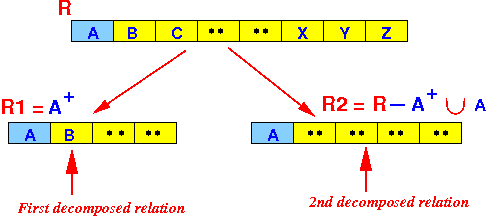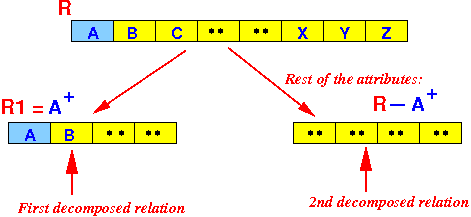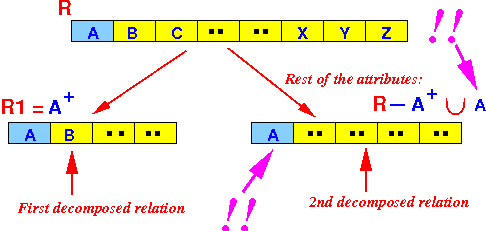- Lemma 2
- content(R) = content(R1) * content(R2)
Let R1 and R2 be a decomposition of R If either R1 ∩ R2 → R1 or R1 ∩ R2 → R2 , then:
- Proof:
- Omitted for brevity.....
- Comment:
- I am using the lemma numbering from the
text book....
In the text book, the above lemma is Lemma 2 (because I skipped some theory stuff to cover the material in a more speedy fashion)
- I am using the lemma numbering from the
text book....
- Suppose the
following functional dependency
in relation R
causes
a violation of the
3NF property:
A → B
(I.e.: (1) A is not a super key and (2) B is not part of a key)
Then you can decompose (= break up) the relation R into the following 2 relations R1 and R2 losslessly:

- Reason:
- Because the
functional dependency:
A → B
you must take out (= break up) all attributes that is functionally dependent of A (the left hand size of the "problem" functional dependency):

So the initial decomposition is:
R1 = relation that contains all attributes in A+ R2 = relation that contains all attributes in R − A+
However:
- This initial decomposition is not guaranteed to be a lossless decomposition !!!
- According to
Lemma 2, if we
add
the attribute A to
the 2nd decomposed relation
(R − A+):

The decomposition will be lossless because:
R1 ∩ R2 = A and: A → R1 Therfore: Since R1 ∩ R2 → R1, by Lemma 2, this decomposition is lossless !!!
- Because the
functional dependency:
- Recall:
Employee1(SSN, FName, LName, PNumber, PName, Hours)
Functional dependencies: SSN → FName, LName PNumber → PName SSN, PNumber → Hours
The key of Employee1 is: (SSN, PNumber)
- We found a violation to the
3rd Normal Form
(i.e., a
"bad" functional dependency):
SSN → FName, LName Because: (1) SSN is not a superkey and (2) FName, LName is not part of a keyApplying Lemma 2, the following decomposition will be lossless:
Employee1(SSN, FName, LName, PNumber, PName, Hours) SSN+ = (SSN, Fname, LName)
We can losslessly decompose (= brake up) Employee1 into: R1 (SSN, FName, LName) R2 (SSN, PNumber, PName, Hours) (because R1 ∩ R2 = {SSN} → R1 !!!)
- Example:
Original relation: Employee1 SSN FName LName PNumber PName Hours 111-11-1111 John Smith pj1 DBApplet 20 111-11-1111 John Smith pj2 WebServer 10 111-22-3333 Jane Doe pj1 DBApplet 5 Decomposition:
R1 SSN FName LName 111-11-1111 John Smith 111-22-3333 Jane Doe R2 SSN PNumber PName Hours 111-11-1111 pj1 DBApplet 20 111-11-1111 pj2 WebServer 10 111-22-3333 pj1 DBApplet 5
- Reconstruction:
(using the decomposed relations)
R1 SSN FName LName 111-11-1111 John Smith 111-22-3333 Jane Doe * R2 SSN PNumber PName Hours 111-11-1111 pj1 DBApplet 20 111-11-1111 pj2 WebServer 10 111-22-3333 pj1 DBApplet 5 = SSN FName LName PNumber PName Hours 111-11-1111 John Smith pj1 DBApplet 20 111-11-1111 John Smith pj2 WebServer 10 111-22-3333 Jane Doe pj1 DBApplet 5 - The
reconstructed content
is the same
as the
original content !!!
I.e., we have perserve the exact content - no more and no less
- The Lemma 2
tells us that
this decomposition
will be
a lossless decomposition:
Employee1(SSN, FName, LName, PNumber, PName, Hours) into: R1 (SSN, FName, LName) R2 (SSN, PNumber, PName, Hours)This decomposition is lossless because:
(1) R1 ∩ R2 = (SSN) and (2) SSN → SSN, FName, LName = R1 !!!
Therefore: R1 ∩ R2 → R1 This property - according to Lemma 2 - guarantees that the decomposition is lossless !!!